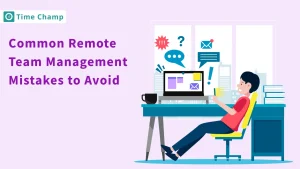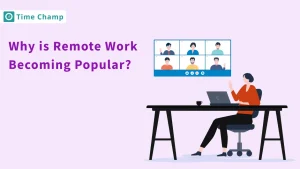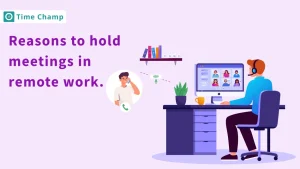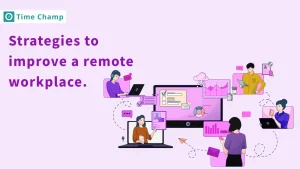Have you noticed that some employees get more attention and opportunities simply because they’re physically closer to management? This proximity bias can lead to frustration and feelings of exclusion among the remote or less visible employees, which has negative implications for the workplace. In this blog, we will learn how to overcome proximity bias and create a more supportive workplace for everyone.
What is Proximity Bias?
Proximity bias, also known as cognitive bias, occurs when managers favor employees who are physically closer to them, usually in the office, than those who work remotely. In hybrid settings, where some team members work remotely and some work from the office, proximity bias can result in unfair treatment, as managers may think that employees they see in the office are more committed or productive.
Examples of Proximity Bias
Do you know that employees who are in close contact with leaders are usually promoted or rewarded more often? This is a clear example of proximity bias. In this section, we will look at some more examples of how proximity bias affects decision-making and results in unfair treatment in the workplace.
Project Assignments
Managers may prefer to assign high-profile projects to the team members who are physically present in the office. This can lead to a situation where remote employees are not considered for a project even if they are capable and willing to work on it, hence unfair distribution of work and opportunities.
Performance Recognition
Employees who interact frequently with managers in person often receive more recognition, such as public praise or awards. On the other hand, the employees who are working remotely may be contributing a lot without being recognized, and this may make them feel unappreciated despite the efforts they are making.
Feedback Opportunities
In-person employees receive feedback right after a meeting or a presentation, and this makes it easier to address the errors. At the same time, remote employees may get feedback with a certain time delay, which can be detrimental to their career growth and their ability to adapt to the needs of the team.
Promotion Considerations
In the case of promotions, managers may tend to promote employees they meet often, thus overlooking remote employees who are equally competent. This can lead to unfair competition where the employees are promoted based on visibility rather than productivity, which affects the morale of the employees.
Mentorship and Networking
Employees who are present in the office have more chances to get the necessary mentorship and informal contacts that can be helpful in their careers. Teleworkers may not be able to interact with other people physically and this may hinder them from getting good connections and directions for their progress.
What are the Causes of Proximity Bias in the Workplace?
A survey reveals that about 42% of employees who work from home believe that they are overlooked compared to their counterparts who go to the office physically. This section looks at the causes of proximity bias and will assist you in identifying why it happens in different workplaces.
Human Nature and Visibility
Managers may unconsciously associate physical presence with engagement and productivity, assuming that employees they see working are more dedicated than remote workers. People also tend to trust and feel more comfortable with individuals they see regularly, leading to a bias toward those they interact with more frequently.
Lack of Management Training
Managers who have been used to working in an office setting may find it challenging to embrace the hybrid or remote working model. If not trained well, they may think that working closely with their colleagues is the best way to improve their performance. Some managers use visibility as a way of measuring productivity because they do not have the means or knowledge on how to properly evaluate remote work.
Communication Gaps
Office employees may have more chances to interact with their colleagues in the hallway or during lunch, which creates deeper bonds and more access to decision-makers. In contrast, remote employees may face communication challenges due to the lack of these casual interactions, making them less visible and not receiving as much recognition as they used to.
Digital Divide and Inequitable Access
Remote workers may also have a problem communicating and sharing information with other workers if they are not aware of the right tools or applications. When remote employees cannot attend important meetings or do not have direct access to tools, their productivity and exposure are affected. This results in the digital cliff effect where the office workers can access the decision-makers and projects more than the remote workers.
The Impact of Proximity Bias on Employees
How does the seemingly trivial decision of who gets to sit near the boss impact the careers and the morale of the employees in ways that we may overlook? This is because proximity bias can lead to small but important disparities in how people are seen and appreciated at work. Now, let us discuss how this bias impacts the working environment for many individuals.
Decreases Morale and Motivation
Remote workers may feel unappreciated, that their work is not as valued as the work of other employees who are physically present in the workplace. This may lead to disengagement and low job satisfaction because the employees may feel that their work is not recognized. The feeling of being “out of sight, out of mind” can be demotivating, especially when in-office employees receive more attention and praise from managers simply because they are more visible.
Limits Career Advancement
Research has shown that employees who work from home get promoted less often than their counterparts in the office even if they are more productive. Such a difference in promotion rates can lead to perceived injustice and unfairness among employees who are working remotely. When talented people feel that their careers are being held back by proximity bias, they are likely to search for other opportunities.
Skewed Performance Review
Another effect of proximity bias is that it distorts performance evaluations in organizations. This is because in-office employees may have more opportunities to present their work to the managers and thus are likely to be considered more productive or involved. The visibility of work can generate the impression of greater productivity, even if the remote employees are working as much or more.
Thus, the remote employees may be rated lower in performance reviews, not because they are slacking, but because they are out of sight. This skewed evaluation can restrict raises, bonuses, and promotions, which puts an enormous disadvantage on those who are not physically in the office.
Reduced Collaboration and Inclusion
Although proximity bias is a problem experienced by an individual employee, it can impact the work of a team and the members of the team. In some cases, when the managers are unaware of it, in-office employees may be given more opportunities to contribute to important projects or meetings. This can minimize the involvement of remote employees and their contribution to crucial decision-making processes.
In the long run, this exclusion leads to two different subgroups within the teams, with the in-office employees being more influential and visible while the remote employees becoming invisible. This can result in a lack of diverse input in decision-making, less creativity, and isolation of the remote workers which is not good for the morale and cohesion of the team.
How to Overcome Proximity Bias in Hybrid Workplace?
“Diversity is being asked to the party, inclusion is being asked to dance.” — Verna Myers. In a hybrid workplace, mitigating proximity bias is critical to engagement. This section looks at how to overcome proximity bias and promote equality in the workplace so that every employee can be productive and feel appreciated.
Implement Clear and Transparent Performance Metrics
To avoid proximity bias, one of the best ways is to set measurable goals and standards that apply to everyone in the organization. This helps to make sure that everyone is assessed according to their performance and not whether they are physically present in the workplace.
Actionable Tip: Use tools like Time Champ to set measurable, outcome-based performance targets. Instead of tracking visibility or hours worked, Time Champ helps you assess productivity by monitoring project completion, work quality, and overall impact. This ensures that performance is measured fairly, regardless of whether employees are working remotely or in the office.
Regularly Schedule Check-Ins with All Employees
Remote employees may not get the same opportunities to interact with their managers and colleagues informally. To counter this, it is necessary to arrange one-on-one meetings with all the team members, regardless of their location.
Actionable Tip: Schedule regular one-on-one meetings with remote workers at least once a week or every two weeks to review their performance, issues, and prospects. This keeps people informed and guarantees that those who work from home are included in current conversations.
Promote Equal Access to Career Development Opportunities
To avoid the remote employees feeling left out of the company’s growth, ensure that they are included in the training sessions, mentorship programs, and leadership opportunities as the other office employees.
Actionable Tip: Create mentorship programs that are accessible to all employees and offer virtual leadership development programs to ensure that remote workers are not left out. When offering high-visibility projects, consider both in-office and remote employees equally.
Leverage Technology to Bridge Communication Gaps
Hybrid workplaces can benefit from using communication tools that keep all team members connected. Video calls, project management software, and collaboration platforms help to ensure that everyone is on the same page, regardless of where they work.
Actionable Tip: For meetings, use video conferencing so that employees can still have face-to-face interaction. Encourage the use of communication tools like Slack, Microsoft Teams, or Trello to make sure that remote workers do not feel excluded from the communication and decision-making process.
Foster an Inclusive Culture
To eliminate proximity bias, it is essential to establish a positive organizational culture that embraces remote workers. Ensure that all the team activities, meetings, and events are planned in a way that they can involve all the members of the team including those who are working from home.
Actionable Tip: Ensure that employees who work from the office and those who work from home are involved in the same meetings. Make sure that the employees who work remotely are also given a chance to participate and be heard. Organize virtual team-building activities to strengthen the relationships between employees working remotely and those working in the office.
Encourage Open Communication and Feedback
Encourage employees to volunteer on how they have been affected by proximity bias or how they have observed it. This open communication makes sure that managers are always alert and ready to note any prejudice that they are displaying and change their behavior when required.
Actionable Tip: Establish channels through which employees can freely report incidences of discrimination or unfair treatment in the workplace. This can help in the detection of proximity bias and help the company deal with any such problems.
Conclusion
Therefore, it is crucial to address the biases that arise in hybrid work environments so that the workplace is fair to all employees. Effective strategies and open communication can make all the employees of the organizations feel valued and appreciated irrespective of the place they work at. Equal opportunities in the workplace not only enhance the morale of the employees but also the productivity and creativity of the organization.
Ready to overcome proximity bias?
Use Time Champ to create a fair, performance-driven workplace. Start today!
Signup for FreeBook DemoFrequently Asked Questions
Proximity bias is highly dependent on visibility because employees who are close to the decision-makers are likely to be seen and given more promotions. This can lead to inequitable distribution of career opportunities and interest for those who are physically remote or less visible.
There are ways that employers can support diversity through flexible work arrangements such as daily virtual meetings and fair performance reviews. Other measures include training on unconscious bias and creating an inclusive culture to ensure that all employees feel valued irrespective of their geographical location.
Cognitive biases, for instance, the mere exposure effect, make people develop preferences for those they come across most often. This can lead to decision-makers making biased decisions in favor of the employees they meet more often, thus discriminating against the remote or less visible employees.
Some of the tools that can be useful in enhancing the communication and visibility of remote workers include video conferencing, project management tools, productivity tracking software, and collaboration tools. In addition, the utilization of performance management systems that are founded on the measurement of performance indicators instead of observations can also minimize the effects of proximity bias.






